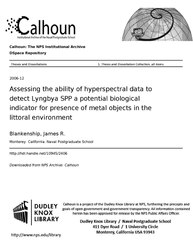File:Assessing the ability of hyperspectral data to detect Lyngbya SPP a potential biological indicator for presence of metal objects in the littoral environment (IA assessingbilityo109452406).pdf

Original file (1,275 × 1,650 pixels, file size: 4.92 MB, MIME type: application/pdf, 262 pages)
Captions
Captions
Summary[edit]
| Assessing the ability of hyperspectral data to detect Lyngbya SPP a potential biological indicator for presence of metal objects in the littoral environment
( |
||
|---|---|---|
| Author |
Blankenship, James R. |
|
| Title |
Assessing the ability of hyperspectral data to detect Lyngbya SPP a potential biological indicator for presence of metal objects in the littoral environment |
|
| Publisher |
Monterey California. Naval Postgraduate School |
|
| Description |
The aquatic filamentous bacteria (Cyanobacterium) Lyngbya majuscula is a nitrogen-fixer found in coastal waters often attached or adjacent to sea grass, algae and coral. It is characterized by phycobiliproteins, unique pigments found only in cyanobacteria. To sustain photosynthesis and nitrogen fixation, L. majuscula requires iron proteins and is therefore sensitive to the availability of this metal. The hypothesis tested in this study concerns the potential use of hyperspectral imaging in detecting L. majuscula in coastal regions as biological indicators for the presence of iron debris or metal objects in the littoral environment. This concept would have potential benefits and applications in mine detection and countermeasure techniques. Using a USB2000 field spectroradiometer, a spectral library was developed for the benthic substrates of Midway Atoll, Northwest Hawaiian Islands, spectrally characterizing L. majuscula and the surrounding coral reef substrates. The data was analyzed to determine unique spectral characteristics of the benthic cyanobacteria in a mixed coral environment and evaluated against the resampled spectral resolution of a number of hyperspectral sensors: Airborne Visible/Infrared Imaging Spectrometer (AVIRIS), Hyperspectral Mapper (HyMap) and Compact Airborne Spectrographic Imager (CASI). The results of the in situ spectroscopy suggest a strong potential for all three sensors to detect these cyanobacteria in a mixed coral reef environment at four distinct wavelengths attributable to phycobiliprotein pigment absorptions unique to cyanobacteria. Of these four discriminative absorption ranges, the phycoerythrin absorption of 565-576 nm shows the greatest potential for segregating cyanobacteria from a mixed algal/ coral / sand environment so long as the coral Montipora spp. is not present within the scene, since it has an overlapping absorption in those wavelengths. In the presence of Montipora corals, these cyanobacteria are more difficult to detect. However, in a mixed environment composed of L. majuscula and Montipora corals, the cyanobacteria can be distinguished by a different phycocyanin absorption, at 615-632 nm. Subjects: Spectrum analysis; Cyanobacteria; Iron |
|
| Language | English | |
| Publication date | December 2006 | |
| Current location |
IA Collections: navalpostgraduateschoollibrary; fedlink |
|
| Accession number |
assessingbilityo109452406 |
|
| Source | ||
| Permission (Reusing this file) |
Approved for public release, distribution unlimited | |
Licensing[edit]
| Public domainPublic domainfalsefalse |
This work is in the public domain in the United States because it is a work prepared by an officer or employee of the United States Government as part of that person’s official duties under the terms of Title 17, Chapter 1, Section 105 of the US Code.
Note: This only applies to original works of the Federal Government and not to the work of any individual U.S. state, territory, commonwealth, county, municipality, or any other subdivision. This template also does not apply to postage stamp designs published by the United States Postal Service since 1978. (See § 313.6(C)(1) of Compendium of U.S. Copyright Office Practices). It also does not apply to certain US coins; see The US Mint Terms of Use.
|
 | |
| This file has been identified as being free of known restrictions under copyright law, including all related and neighboring rights. | ||
https://creativecommons.org/publicdomain/mark/1.0/PDMCreative Commons Public Domain Mark 1.0falsefalse
File history
Click on a date/time to view the file as it appeared at that time.
| Date/Time | Thumbnail | Dimensions | User | Comment | |
|---|---|---|---|---|---|
| current | 19:15, 14 July 2020 |  | 1,275 × 1,650, 262 pages (4.92 MB) | Fæ (talk | contribs) | FEDLINK - United States Federal Collection assessingbilityo109452406 (User talk:Fæ/IA books#Fork8) (batch 1993-2020 #8304) |
You cannot overwrite this file.
File usage on Commons
The following page uses this file:
Metadata
This file contains additional information such as Exif metadata which may have been added by the digital camera, scanner, or software program used to create or digitize it. If the file has been modified from its original state, some details such as the timestamp may not fully reflect those of the original file. The timestamp is only as accurate as the clock in the camera, and it may be completely wrong.
| Short title | Assessing the ability of hyperspectral data to detect Lyngbya SPP a potential biological indicator for presence of metal objects in the littoral environment |
|---|---|
| Author | Blankenship, James R. |
| Software used | Blankenship, James R. |
| Conversion program | Acrobat Distiller 6.0.1 (Windows) |
| Encrypted | no |
| Page size | 612 x 792 pts (letter) |
| Version of PDF format | 1.4 |

